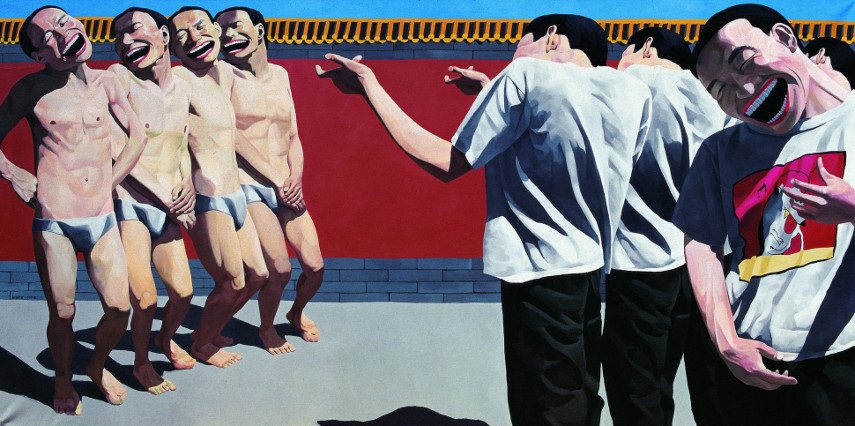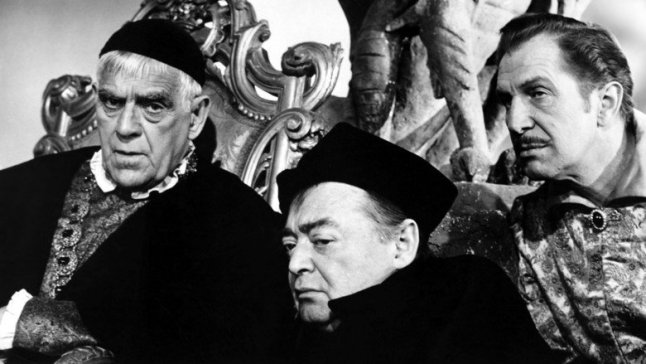In three iconic performances, hangdog-faced character actor Harry Dean Stanton’s roles align with the spaces his characters inhabit.
Long TakeOn July 14th, 2017, he’ll be 91 years old. Think how much cinema history has passed in 91 years. If you launch yourself 91 years into the past, there was still no such thing as a sound film. You know him.
Though Harry Dean Stanton didn’t appear on screen until 1956, his face – hangdog, weather-beaten, soulful – has been a fixture on celluloid (and now, digital), virtually essential to any detailed understanding of the American cinema, since the middle of the twentieth century. He toiled on television, and in bit parts throughout much of the 1950s and 1960s, often in westerns, seemingly the ideal setting for his unique look and energy. But from there, hop, skip, and jump through a laundry list of iconic films on either side of the New Hollywood period, and you’ll find Stanton. That’s him taking it off, boss, in Cool Hand Luke. He’s out on the road in Two-Lane Blacktop. He’s an FBI Agent in The Godfather, Part II. He has the great honor of being gunned down by a prairie-dress wearing Marlon Brando in The Missouri Breaks.
This is just to recount some of Stanton’s Zelig-like, witness-to-cinema-history profile. If IMDB is to be believed (and maybe it isn’t), he’s in Hitchcock’s The Wrong Man. I couldn’t find him, but maybe he’s in there somewhere, the same deep eyes, the same descending features. At the other end of that list of credits is a truly strange and wonderful appearance as a security guard in The Avengers (2013), discovering a naked Bruce Banner (Mark Ruffalo) after a Hulk-fall-from-space, amidst a pile of rubble.
His appearances in film and television (including a frightening few years as terrifying antagonist Roman Grant on Big Love) are too numerous to explore in total. Stanton’s most iconic and important performances, however, are bound together by the actor’s connection to the space his character inhabits. A Harry Dean Stanton character becomes one with the land, drawing out its essential elements, finding a home wherever he is.
“Right”It’s hard to overstate the contribution of Ridley Scott’s Alien (1979) to the horror/science fiction genre. Ask Roger Corman, who seemed to knock it off about twice a year in one form or another, about that. And it’s for good reason, too. Sigourney Weaver launched an essential heroine in Ellen Ripley. The story/script, by Dan O’Bannon and Ronald Shusett, created an outer space that wasn’t a western landscape governed by laws of good and evil, but a nightmare. Artist H.R. Giger’s sex-infused designs for the creature birthed new terror. Scott’s direction set the template for many science fiction films to follow, with a dirty, grimy working class-conscious setting. And most of all, the effects-driven moment around the dinner table exploded onto the screen in an instantly iconic cinematic moment.
I can picture the creature’s birth scene, via John Hurt’s rib cage, as vividly as anything in my own real life, having first seen it at age ten. But, as I’ve gotten older, it’s a scene a bit later that makes a stronger impression. It’s not as showy as the chestburster moment, of course, but it’s a scene where Scott’s craft combines with Harry Dean Stanton’s beleaguered performance as working class space mechanic Brett to produce a riveting example of suspense filmmaking.
Brett’s on screen foil is Yaphet Kotto’s Parker, and together they fit the setting of the film more than any of the other cast. At the heart of Alien’s first half is a class-based narrative about who decides what work gets done, and who does the work. The scenes featuring Brett and Parker are concerned primarily with the blue collar labor on the ship – repairing it after its rough landing on the planet, or an argument with Dallas (Tom Skerritt), the captain, over their perception of unfair compensation. Kotto, African-American, and star of 1978’s auto-worker social criticism drama Blue Collar (Dir. Paul Schrader) has no trouble selling himself as a put-upon working man. Neither does Stanton, whose performance elides with Scott’s vision of the space. His rumpled look, from the top of his head, adorned with a roughneck’s Nostromo baseball cap, down to his feet, nestled in white Converses, suggests a trucker, or a steelworker, or a man on an oil rig in the Gulf of Mexico.
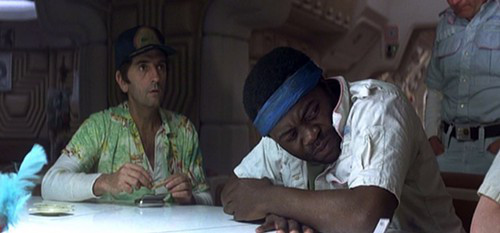
Stanton’s performance, like his clothes, feels lived in. There’s a weariness to the way he delivers his lines, like his explanation of the limited weaponry (like a cattle prod, he says) the crew has been able to cobble together to defend themselves against the newly born alien: “It shouldn’t hurt the little bastard, unless its skin is thinner than ours. But it will give him a little incentive.” There’s a world-beaten tone in his voice, laced with a sardonic detachment – after all, Kane (Hurt) has just given birth to the alien at dinner. Something in Stanton’s delivery commits him to the job that Brett has to do. He gives the cattle prod a zap to demonstrate. There’s work to be done. Brett’s going to do it.
Back to the scene I mentioned earlier. After dinner, and Kane’s death, the remaining crew members split up to search for the creature. Brett, Parker, and Ripley find what they think is the alien, hiding in a storage locker. They open it, and out jumps the ship’s cat, Jones, in a classically structured jump scare. In fear that they’ll pick up the cat on the tracker, Parker suggests Brett go after Jones, who has run away. Stanton invests the moment where he agrees with obvious reluctance, clearly nervous at going off on his own.
The first shot of the scene, which takes place in a large, warehouse-looking area of the massive ship, is a centrally framed image through the double-wide doorway. Stanton enters in near-silhouette, calling for Jones. In what must have been a Stanton improvisation, he meows twice, loudly, and then follows it up with a dismissive, “Kitty crap,” then a harsh, no-nonsense, “Jones!” He steps into the storage area, its space making him look small against the high ceilings, the brownish, dirty, metallic walls.

Much discussion should be had of Scott’s supreme command of both images and sound in this sequence. The frames alternate between wide shots emphasizing the largeness of the space and mediums obscured by loading equipment and supplies, making us aware of all the places the creature could be hiding; the empty, hollow noise that fills the soundtrack with a rumbling dread is coupled with an escalating heartbeat as Stanton steps into a closeup, nervous sweat running down his face, which is marked by fear.
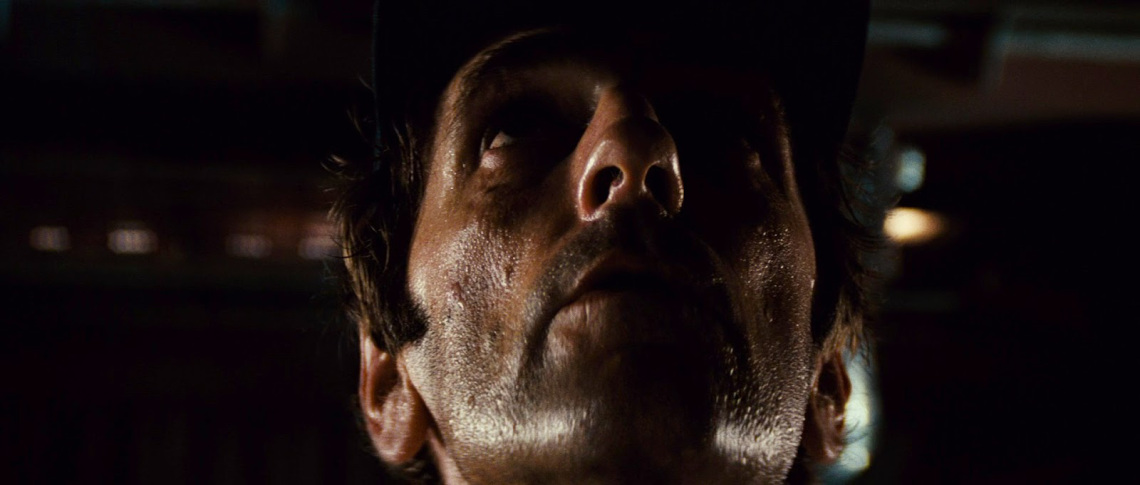
There are a couple of key Stanton moments in this sequence that stand out. He does the scene almost entirely without dialogue, and even the few things he does say are meaningless calls to the cat. The first moment, conveyed entirely on his face, is when he nearly grabs Jones, who is hiding in a forklift-looking piece of space-age equipment. Jones skitters away, but something falls to the floor at Stanton’s feet, next to the Converse. He reaches down, and picks it up – slippery, slimy. Scott cuts into a close up on Stanton, and his face silently moves from disgust to confusion to realization to near panic, all within seconds. He drops the alien’s skin, which means it’s gotten much bigger, and moves on.
Another moment where sound and Stanton’s performance come together occurs in the second half of the sequence, where Brett steps into a room off the main storage floor. Scott’s production design marks this space as darker – the walls are grayish, disappearing into black in some areas. An unknown source of water drips down from the ceiling in steady streams, gathering in small pools on the floor. Most ominously, an air current tosses about some dangling metal chains, which clink and clatter unnervingly.
Here’s where Stanton takes over, with the space established. He steps under the dripping water, and it drums on the bill of his trucker hat. He removes his hat, and tilts his face up, letting the water splash him. This closeup works as a counterpoint to the heartbeat closeup from the sequence’s first half – before, Stanton was nervous, panic-stricken. Here, he finds a moment of placidity, relief, as the cleansing water wipes away the sweat of fear. It’s an eccentric, human pause in the narrative progression that seems uniquely to arise from Stanton’s inhabitance of Brett.
The sequence, of course, ends with Brett’s death, as the alien, now fully-grown, surprises him from behind. Stanton exits the film just after its halfway point, but what we have seen is an actor, not just in this extended sequence, but throughout the film, who is uniquely bound up with his environment. His blue collar costume, his backbroke demeanor, his wit, his comfort with the space, all collect into a quintessential supporting performance that conveys the film’s class arguments in the body of a sympathetic, likeable character who feels irreplaceable once he’s whisked away by the alien, his echoing screams heard against a shot of the watchful eyes of Jones, the job Brett left unfinished.
“Repo Code”Alex Cox’s 1984 film Repo Man nearly defies description. It’s shot through with nuclear era panic, boxed up in the movie’s Macguffin, a Chevy Malibu with a trunk full of radioactive material capable of frying a state trooper into nothing but a pair of leftover, smoking boots. It’s also a kind of document of the Los Angeles punk rock scene in the 1980s, as its characters sport leather, combat boots, ripped jeans, and any number of distinct, aggressive hairstyles. Occasionally, the film is hyper-violent, like during a convenience store robbery that leaves several of those LA punks dead. Then, it turns on a dime and becomes a near-farcical absurdity, indicting consumerist culture with its production design – Emilio Estevez’s Otto, at one point, spoons a meal from a can labeled ‘FOOD’. It all shuts down as a bizarre fairy tale, a magic car ride through the LA sky, powered by atomic juices and Tracey Walter’s Miller, who might be an alien?
But there’s noir DNA in here too, and not just in the seemingly overt gloss on Robert Aldrich’s Kiss Me Deadly (1955), with its own shock of radioactive light, but at the heart of the film’s critique of the American Dream, so important to the rain-slicked noir streets of Los Angeles in the 1940s and ‘50s. The noir world is where Harry Dean Stanton’s performance as Bud, the veteran repo man who serves as Otto’s mentor and friend, anchors the film’s fatalism, its sense that there are nothing but dead ends in the city. While Otto and Miller fly away in their green-glowing Malibu, bound for parts (galaxies?) unknown, Bud is left to die in the parking lot of the repo center where he worked, shot down by police from a helicopter as he went for broke, trying to repo the Malibu for himself on what Bruce Springsteen might have called “a last chance power-drive.”
Stanton, who in his youth made much of his way in the western genre, here seamlessly blends into LA’s urban space. He’s introduced almost backhandedly, as Cox’s camera tracks past a parked car, alongside Otto. Stanton’s Bud is sitting in the car, and, upon noticing Otto, asks him, “You want to make ten bucks?” Otto thinks he’s cruising, and dismisses him, but it’s an essential overture to Bud’s driving force throughout the movie – his desire to improve his station in life, to combat the dissatisfaction he feels with the humdrum day-to-day of a repo man, a job he doesn’t want to do, a life he doesn’t want to live. His first appearance is framed against a fence, behind which is a mountainous wall of ruined, discarded junk. This world is what Bud will spend the movie trying to escape.
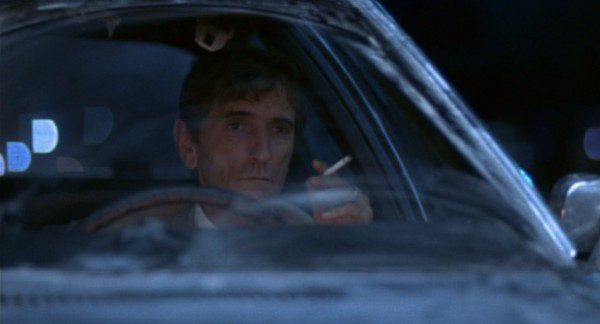
His relationship with Otto begins on a lie, but one that establishes a key dynamic. Bud tells Otto to jump in a car and drive off with it, claiming it belongs to his “old lady,” and that they need to get it out of a “bad neighborhood.” He’s tricked Otto, though, into repossessing the car for him. When they return to the yard, and Otto inquires about Bud’s “old lady,” Bud laughs. It’s clear he’s not married. In fact, above his desk is the picture of a model from a magazine. That’s because Bud’s life is animated by desire for something greater, an idealized vision of what could be, rather than what is, a classic noir theme.
Once Otto officially joins the repo outfit, Bud tells him, “It helps if you dress like a detective.” Stanton’s costume, once again, is essential for understanding his place within the larger dynamic of the story at work. He seems just as at home in his rumpled suit, grays, browns, and blacks, as he did in his rumpled working-class look in Alien. What carries over, and still lives inside the clothes, is the weariness, that overriding sense that this is a man to whom the world has been less than gentle. Yet, as with Brett, there is resilience in his performance, an energy that fights against the exhaustion. He can go from low-key lamentation of his place in the world to violently lashing out at the Rodriguez brothers, a pair of rival repo men, seemingly with the flip of a switch.
The wayward, radioactive Malibu becomes Bud’s white whale. He wants to find it, and collect on the reward, so that he can “go indie,” boasting of his great “credit,” which he says is “what free society is founded on.” For much of the movie, Stanton imbues lines like these with the certitude of someone from the post-WWII generation, who buys into the American system wholeheartedly, despite the fact that he’s been marginalized by it. He’s a striver, a man who lives by a self-articulated code, informed by the values that make up a righteous view of America.
It starts to go south, however, as Stanton’s performance becomes increasingly unstable; Bud becomes erratic, leading a violent raid against some customers who gave Otto a black eye, but ending up in a high-speed confrontation with the Rodriguez brothers, Stanton behind the wheel, driving like a man possessed. There’s an animal rage in his eyes when he swings a baseball bat at them, and his fellow repo men have to hold him back. He makes another spectacle of himself in a single-take wide shot in the following scene, where he gets fired from the repo operation. His hair grows wilder, untamed, his suit begins to come apart, the tie loosened, the sleeves rolled up. The darkness of noir desperation begins to fill his eyes.

The movie’s climax is key, as Bud, escaping from the hospital to pursue the Malibu, finds it at the yard. His head wrapped in a bandage, Stanton, appearing nearly drunk in the way he moves his head and slurs his speech, tells the approaching Otto: “Shit. Eleven years of repoing cars, and what have I got? Shit.” He sees the Malibu as his one last chance to get his piece of the American Dream, and gets shot down for his trouble, bleeding out in the repo yard.
Stanton’s function in the film is to represent the generation of noir anti-heroes who run into a capitalist, moralist buzzsaw. For their rebellion, they are punished brutally, often with their lives. While Bud’s ultimate fate is left uncertain (the movie flies off with Otto and Miller in the green car), what is for sure is that his dreams, however small they might have been, have been dashed.
“Raggedy and Wild”The apotheosis of Harry Dean Stanton’s career is generally recognized to be Wim Wenders’ 1984 road movie opus, Paris, Texas. Written by playwright and actor Sam Shepard, it’s hard not to see why. Stanton, who spent nearly his entire career playing second, third, even fourth fiddle, finally gets to take the lead and carry a film on his own. It’s his movie through and through, his emotional journey that becomes the audience’s emotional journey.
The American Southwest is the setting, and once again, Stanton’s performance asks him to become one with the space. The film’s opening moments, wherein a haggard man, looking wind-blown and rumpled (again) in a tattered, dirty suit with no tie, approaches the camera out of the dust of the desert, are profoundly disorienting. Ry Cooder’s twangy guitar score accompanies Stanton’s arrival, his bearded face cracked and sunburned.
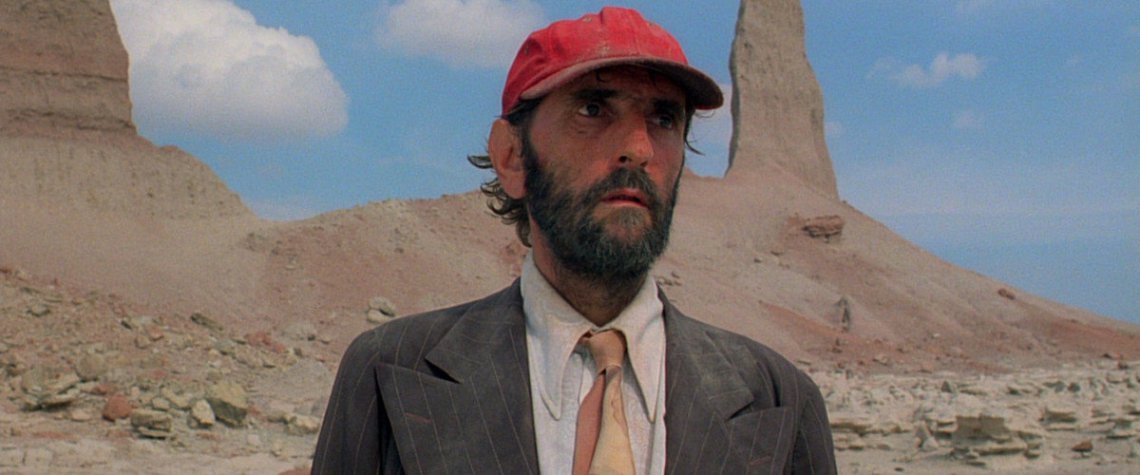
We have no idea who this is. And we don’t know. And we continue not to know. We don’t even really know when we actually find out – his name is Travis, and his brother Walt (Dean Stockwell) comes to the Texas/Mexico border to find him. The reason we don’t know is that Stanton doesn’t utter a single world until nearly twenty-five minutes into the film. Instead, he’s dead silent, a desert wanderer rendered mute by years of self-imposed exile, brought about under vague circumstances. He had a wife, we find out, and a young son, Hunter, whom Walt and his wife Anne (Aurore Clement) have taken in and raised as their own. He’s been gone for four years, Walt tells us. Just gone.
Once Stanton does speak, and shave the beard down to a mustache, and pull on some clean clothes, the same lost, bewildered eyes guide his performance for much of the movie’s nearly two and a half hour running time. Here is a man who has carpet-bombed his life and everything that used to be important to him, leaving behind a pile of emotional rubble.

Stanton’s performance is best understood, once again, in relationship to the environment around him. After Walt comes to collect him from Texas, and they make the long drive back to Los Angeles, Wenders makes a comparison between the two brothers when he shoots out the front windshield of their car. Travis asks to drive the car, and Walt agrees. A shot of the rearview mirror, with Travis’ eyes contained within it, and the small desert town out the front of the car, marks Travis as a man at home in the dusty landscape where we first saw him. Walt, on the other hand, gets the exact same shot, but against the busy freeways of Los Angeles.
It’s telling that an actor of Stanton’s caliber could make two films in the same year, Repo Man and Paris, Texas, and seem equally at home in Los Angeles in the former and like a stranger there in the latter. In LA, he’s alienated, distant; staying at Walt’s, there’s a moment where he takes off, walking to nowhere, somewhere, anywhere. Wenders tracks with him as he walks across a bridge over a freeway, just as he walked in the opening of the film, through the desert. This time, though, his feet can’t get away from the concrete that spreads out before him. He could keep walking, and walking, and walking, and seemingly never get far enough away from civilization.
Wenders withholds the full story of Travis’ exile from us until the last possible moment. What keeps the movie going, and keeps Travis interesting, is the man in his clothes. Without Stanton’s ability to pull us into Travis’ deep sense of pathos, it’s unlikely we’d bother with this damaged, broken individual for this length of time. He imbues each moment of his considerable screen time with the sense of an open wound.
And he is wounded. Travis’ wife Jane (Nastassja Kinski) has gone missing, run away from him and their son. He finally decides to find her, and enlists Hunter’s help, tracking her to a peep show in Houston. Made up of a pair of scenes near the film’s conclusion, the confrontation between lost husband and lost wife flips the movie’s construction on its head. Stanton, asked to keep totally silent for the first fifth of the movie, now does the majority of his work using only his voice. The peep show scenes, where Travis speaks to Jane through the two-way mirror used to protect customers’ identities from the girls, are heavily reliant on the telephone that lets him talk to her. His voice fills her side of the room, through the glass, emanating from a tiny intercom speaker.
Wenders spends the majority of the first time Travis visits Jane on Stanton’s side of the booth. He is almost like a photograph of someone from the Civil War, he’s so still. He lets his lines slip softly, calmly, warmly; tears well around his eyes and streak down his face, but his voice doesn’t crack. He holds the phone, stares at Jane through the glass, knowing she can’t see him, suddenly close-to-reunited with the person who in her own way, sent him into the desert and brought him back out again. He’s all sweetness, until she mentions something about other men, and he lashes out, suddenly animated by jealously, all the warmth dropping out of his voice. In this moment, which we see from Jane’s side of the booth, with Travis obscured by the mirror, is all vocal, and it’s surprising. We haven’t heard Travis speak this way up to this point. We haven’t seen a trace of anger, just deep, seemingly impenetrable sadness.

The anger revealed here is paid off when Travis returns to the peep show a second time. This time, he doesn’t get angry. He meets Jane again, and asks if he can tell her a story. She agrees. He turns his chair around, as if he can’t face her, even though he knows she can’t see him. He lets his voice do the work, as he recounts, explains, apologizes for, and pleads with, in a lengthy monologue only spottily interrupted by Jane’s interjections. He confesses to her, to us, behavior during their marriage that seems a far piece from the Travis we’ve seen throughout the film, save for that one moment of jealousy in the booth, just a few scenes earlier.
This time, there are no tears dripping from Stanton’s eyes. Just the calm of someone who knows what he wants – for Jane to agree to come back, not to him, but to Hunter. After she realizes it’s Travis on the other side of the glass, she has her own moment of doubt and pain. But she agrees to come to the hotel where Hunter is staying. She gets there, but Travis is gone.
Stanton, as Travis, returns to the landscape. Maybe he’s heading for Paris, Texas, the town that holds the land he bought, where he thought his future family might live. Maybe he’s going back to the desert. Maybe he’s going nowhere, somewhere, anywhere.
“Reverie”There’s a scene in Sean Penn’s 2001 film The Pledge, starring Jack Nicholson, where Stanton appears. He’s not the only recognizable face in Penn’s film, which boasts an impressive gallery of big name actors (Helen Mirren, Vanessa Redgrave, Mickey Rourke – the list goes on), each appearing for a scene or two. Nicholson’s detective character, Jerry Black, is on the hunt for a child-killer that nobody else seems to want to find. He stops at a gas station which he believes is near the killer’s hunting grounds, and contrives to buy it so he can survey the area. Its owner, Stanton’s Lloyd, initially doesn’t want to sell, but gives in. We don’t know why. Stanton doesn’t get to challenge Nicholson’s increasingly unstable detective, like Mirren, who plays a child psychologist. Stanton doesn’t get to contain emotions behind the unmistakable darkness of deep guilt, like Redgrave’s grandmother of the victim character. Stanton doesn’t get a showy monologue, like Rourke, who breaks down over Nicholson’s reminder of his own missing daughter, possibly a victim of the same perpetrator.

Nicholson shows up, buys the gas station, and then Stanton is gone. But Penn knows what he’s doing. Stanton’s demeanor, his face, his entire body tell us everything we need to know about this person. There’s an inner life there, behind the appearance of nothing doing, in a moment which barely registers as a cameo. The key moment occurs in one shot, as the transfer of the keys to the gas station is taking place. Stanton stands, outside the station, a place that’s clearly been his entire life for as long as he can remember. He takes a drag on a cigarette, and as Nicholson’s car approaches, the dust from the gravel lot kicking up around Stanton, he threatens to disappear into the air, like he was never there to begin with. He’s a nowhere man, whose life isn’t important to this story, but in doing so little, in the simple act of being himself, Stanton brings out an entire character’s history with the dignity of silent stillness.
As Stanton hands over the keys, he rushes away, presumably before he changes his mind and collapses under the weight of his own regrets, getting into his car with his granddaughter, headed for Arizona. He chatters absentmindedly, slams the door, and speeds off, taking his two minutes of screen time with him. He’s gone. And, as compelling as Nicholson’s search for the killer is, the power of Harry Dean Stanton is that for a moment, you’d rather go with him.
Advertisements Share this:
